Control Freak
- By John K. Waters
- 06/01/07
Got interactive whiteboards and control podia?
Watch out: They're about to become obsolete.
Here's the inside track on the new super-interactive
electronic boards and New Age presentation podia
--the ultimate in AV/IT control.
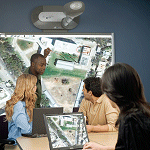 THE HOTTEST TECHNOLOGY trends in higher ed today can be boiled down to
two roughly converse capabilities: the delivery of time- and space-shifted instruction to individual
students (think podcasts), and the coordination of disparate-source content within the
classroom, for enriched group experiences. The first is taking advantage of existing, mostly
consumer-oriented platforms such as iPods, web browsers, and PDAs. But the second is driving
innovation in two distinct product categories--electronic whiteboards
and audio-visual (AV) control systems--whose feature sets are growing, and
even beginning to overlap.
THE HOTTEST TECHNOLOGY trends in higher ed today can be boiled down to
two roughly converse capabilities: the delivery of time- and space-shifted instruction to individual
students (think podcasts), and the coordination of disparate-source content within the
classroom, for enriched group experiences. The first is taking advantage of existing, mostly
consumer-oriented platforms such as iPods, web browsers, and PDAs. But the second is driving
innovation in two distinct product categories--electronic whiteboards
and audio-visual (AV) control systems--whose feature sets are growing, and
even beginning to overlap.
"College classrooms have undergone great changes because of computers
and the internet," says Randal Lemke, executive director of InfoComm International, the nonprofit association of the AV communications
industry. "They now have an amazing array of resources available
from the web, content servers, DVDs, and other media, and even other classrooms.
But you have to be able to display all of that; manage and interact with
it. There's a real need to pull it all together, and that's making higher education
the second largest vertical market in our association."
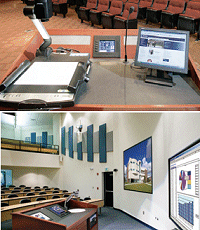 According to a November 2005 InfoComm study, colleges and universities
increasingly see classroom tech as an investment rather than an expense,
because of its ability to attract students. Highlighting that growing understanding
of classroom tech as competitive edge, the rate at which colleges and
universities outfitted their classrooms with AV systems doubled between 2000
and 2005, the study found. InfoComm expects that growth to continue at a
rate of 25 to 30 percent per year until at least the year 2010. (The association
is set to offer updated statistics at the upcoming InfoComm '07 trade show, June 15-21 in Anaheim, CA.)
According to a November 2005 InfoComm study, colleges and universities
increasingly see classroom tech as an investment rather than an expense,
because of its ability to attract students. Highlighting that growing understanding
of classroom tech as competitive edge, the rate at which colleges and
universities outfitted their classrooms with AV systems doubled between 2000
and 2005, the study found. InfoComm expects that growth to continue at a
rate of 25 to 30 percent per year until at least the year 2010. (The association
is set to offer updated statistics at the upcoming InfoComm '07 trade show, June 15-21 in Anaheim, CA.)
Those statistics don't surprise K.
Watson Harris, director of academic
technology planning and projects at
Middle Tennessee State University in
Murfreesboro. "Both students and parents
expect the latest technology to be
there," she says. "Not only do the students
use it to learn the course material,
but they gain valuable, marketable skills
in the technology itself--in high-end
presentation tools, collaborative multimedia
interaction, and podcast creation--
and they even gain some
experience through simulated case studies
and serious games. A couple of projectors
and a PowerPoint presentation
won't cut it today."
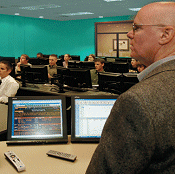 In fact, Harris spends much of her
time looking for and road-testing the
latest classroom technology. MTSU
spends nearly $5 million a year on
instructional technologies, and Harris
administers those funds; using them to,
among other things, try out new products
in a special classroom housed in the
school's Honors College.
In fact, Harris spends much of her
time looking for and road-testing the
latest classroom technology. MTSU
spends nearly $5 million a year on
instructional technologies, and Harris
administers those funds; using them to,
among other things, try out new products
in a special classroom housed in the
school's Honors College.
"It's used as a showcase; kind of an
experimental lab to introduce ideas to
the faculty and the brightest students,"
she explains. The Honors College provides
a "small university experience"
within the 23,000-student MTSU campus,
Harris says, "so we experiment. If
we can introduce new technology in the
Honors College, we can see where the
demands are and introduce it into our
regular classrooms."
Interactive Whiteboards: Morph and Dazzle
FOCUS ON THUNDER
PolyVision's Thunder takes the whiteboard concept and enhances it with a host of
computing and collaboration capabilities. The digital flipchart accepts input from stylus,
finger, or digital source, and controls multiple 'pages' that can be projected onto nearby
walls. Images can be shared, annotated, saved, recalled, displayed, or e-mailed.
Last year, MTSU began testing PolyVision's
Thunder Virtual Flipchart System, an innovative
electronic whiteboard designed to accept
input from just about any source,
including laptops, scanned images, and
video. The project was really something
of a beta test, Harris says, because
MTSU was the first university in the
country to use the product.
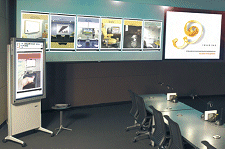
POLYVISION'S THUNDER turns a presentation area into a wall of virtual flipcharts for collaboration.
"We were looking for cutting-edge
technology," she says. "We wanted
something that would encourage students
to be actively involved, to do their
own research, collaborate on that
research, and then be able to bring it
back into the classroom and share it.
Thunder just makes that a natural."
The Thunder Virtual Flipchart System
might be thought of as a super-interactive
whiteboard, but execs at Suwanee, GAbased
PolyVision prefer not to use that
term and, indeed, it's fair to say that
Thunder is a category-defining product.
"A whiteboard is a presentation tool,"
says PolyVision operations manager
Gwen Dubois, who prefers to think of
Thunder as a "global collaboration tool
with presentation capabilities." She
explains, "A whiteboard has one window
of information, while Thunder provides
multiple windows. It's really not
the same thing at all."
In truth, Thunder takes the whiteboard
concept and enhances it with a
whole host of computing and collaboration
capabilities. At the center of the
system is a "group easel," which serves
as the digital flipchart. The easel
accepts stylus input (a finger works, too)
and controls multiple "pages" that can
be projected onto nearby walls. It
accepts input from virtually any digital
source: servers, local laptops, scanners,
DVDs. All images can be shared, annotated,
saved, recalled, displayed, and
distributed via e-mail. And the images
can be shared in real time with other
Thunder setups anywhere in the world.
Still, the advent of Thunder doesn't
mean that the more traditional electronic
whiteboards are going away; they're just
acquiring features. For example, one of
the best-known electronic whiteboard
manufacturers, Smart Technologies, is billing its latest
offering, the Smart Board 600i, as "a
complete classroom media management
solution." The system combines an interactive whiteboard with a projector and an
audio system. But it also allows users to
connect up to six external media sources
(computers, VCRs, DVD players, or document
cameras) to an extended connection
panel, creating a kind of central
media hub. Users can switch among
inputs from these devices using the interactive
whiteboard's on-screen menu. The
whiteboard capabilities allow users to
write over video or any input connected
to the system. And these notes can be
saved to a USB storage device.
Thunder's collaboration capabilities
definitely set the product apart, but the
way it and the 600i unite the old-school
markup features of whiteboards (what
InfoComm's Lemke characterizes as
"the room to scribble") with a central
manager of content sources, is catching
on in another product category, as well.
Ultimate Control at the Podium
FOCUS ON SMART
The Smart Technologies system combines an interactive whiteboard with a projector
and an audio system, and allows users to connect up to six external media sources,
switching among inputs via the interactive whiteboard's on-screen menu. Users can
write over video or any input connected to the system, and notes can be saved to a
USB storage device.
"There's now a real demand for the ability
to annotate or draw on top of whatever
information is being displayed," says
Mike Carter, director of technical sales
at control and automation technology
company AMX, who
explains that the capability is now built
into all of the vendor's touchpanels. The
touchpanel interfaces are present in many
of the company's AV control consoles,
which consolidate controls for groups of
computers, projectors, media players,
document cameras, streaming media
sources, and monitors. The product line
also includes a series of personal digital
media servers designed to store, manage,
and distribute digital audio and video.
At Crestron Electronics, AMX's nearest competitor,
touchpanels interface--via electronicwhiteboard-
like capabilities--with the
company's AV control systems. Crestron's
MediaMarker, for one, enables
real-time annotation over still images,
computer graphics, live video, and even
streaming media, directly from the
touchpanel display. And touchpanel
graphics can be output to an external
display, along with speech audio (from
the built-in microphone) and stereo program
audio.
You see the ability to pull in content from anywhere, and then mark it up, appearing in both the new AMX and Crestron systems. -- Alfred Poor, Pacific Media Associates
"The common thread [among these
products] is their ability to control the
presentation environment, whether it's
the AV control podium or the whiteboard,"
observes Alfred Poor, senior
research associate at high-tech market
research and publishing firm Pacific Media Associates. "You see this ability to
pull in content from anywhere, and then
mark it up, appearing in both systems.
This is a popular feature in schools and
corporate meeting spaces, because
those environments generate a lot of ad
hoc content. People come up with ideas;
they brainstorm. Teachers and students
interact with each other, and you want to
be able to capture some of that."
But that doesn't mean that the presenter
must be glued to a lectern at the
front of any one room or space, or wired
to the network, for that matter. Notably,
PolyVision offers the Walk-and-Talk
Cordless Lectern, an AV controller on
wheels. In podium-based control stations,
the podia (which are actually
lecterns, but carry the now industrystandard
misnomer) house computers
connected to local area networks, and
various media players linked to projectors
and sound systems in the classrooms. But
the PolyVision product comes equipped
with a touchpanel interface that accepts
stylus input, remote controls designed to
allow users to control computer applications
from any point in the room, an
eight- to 10-hour rechargeable battery
capable of powering two devices, and
wireless capability. (The MTSU Honors
classroom is equipped with a PolyVision
Walk-and-Talk Cordless lectern.)
Predictably, as the AV controller
makers squeeze more and more functionality
into their products, expect to
see them sporting larger touchpanels,
Carter says. The demand for the annotation
capabilities, in particular, is forcing
AMX, for one, to expand its "control
surface." The company's Modero touchpanel
line, for example, now includes a
17-inch version (in addition to its 15-,
12-, 10-, 8.4-, 7.5-, 7-, and 5-inch
Modero offerings). The Modero VG
Series widescreen touchpanel can display
RGB and component video
sources, analog stereo audio, streaming
MPEG-2 digital video and audio, and
network video. It uses industry-standard
Ethernet connectivity for both wired
and wireless networking.
To Centralize, or Not?
One trend that seems to be contributing
to the evolution in both whiteboards
and AV controllers is the move in a growing number of schools to a centralized
content-management architecture.
"They're looking at standardizing the
technology so they can grow and add
capabilities as they need them," says
AMX's Carter. "The concept of a handful
of classrooms with AV control technology
in them is a thing of the past. Now
it's virtually every classroom on campus.
At larger schools, you're talking about
hundreds of classrooms." Though Carter
would of course be thrilled to see his
company's products in every classroom
on every campus, he is not exaggerating
the campus interest in centralized control.
In fact, for Ernie Bailey, director of
audiovisual services in the Office of
Academic Services at the University of
Arkansas for Medical Sciences in Little
Rock, the most useful AV controller
innovation of recent years is remote
administration--a feature now offered by
both Creston and AMX.
"Remote access to the equipment
allows me to better manage the technology,"
Bailey says. "I can check how
many hours [the control podium] has
been turned on, which buttons are being
pushed, and which features are being
used. I might notice, for instance, that
none of the presenters are using the
VCRs, so when I design a new room, I
might leave that piece of equipment out
of the mix."
FOCUS ON CONTROLLER STANDARDS
Cornell's Greg Bronson is one of the driving forces behind an InfoComm-sponsored
Dashboard for Controls initiative to encourage system integrators to provide AV
controller interfaces with a consistent look and feel. Supporters believe that operation
of a professionally installed AV presentation system should be as easy as driving
a car. 'Why should AV controller interfaces be any different?' he asks.
For its part, Crestron offers the
RoomView software package with its
systems. RoomView provides remote
control, monitoring, and resourcemanagement
capabilities; it presents a
"big-picture view" of a campus' entire
presentation setup. Administrators and
support staff can use it to perform remote
system diagnostics, track the usage of
projector lamps, log network activity,
and automate tasks through event scheduling.
The program even allows administrators
to lock out selected rooms remotely,
to prevent unauthorized use of TVs,
CD players, and other AV equipment.
Crestron systems now come with a basic
version of RoomView, which supports 25
rooms; an enterprise edition, available
for a fee, supports hundreds of rooms and
unlimited users.
For system monitoring and maintenance,
AMX's Resource Management
Suite software includes the Classroom-
Manager application, designed to provide
real-time system monitoring of equipment
status, power usage, and projector
lamp hours. A Hot List screen displays
equipment and areas on campus that
require technical support, while a realtime
interactive help desk feature allows
users in the classroom to send help and
maintenance messages to IT support
staff. The AMX software supports preset
equipment configuration, recurring reservation
scheduling, and conflict resolution.
And it provides a web-based
graphical user interface (GUI).
Equipment control and management
notwithstanding, one of the most useful
features of this type of software is the
classroom-scheduling capability, says
InfoComm's Lemke. The scheduling
capability allows administrators to organize
not just who gets to use the classrooms
and when, but also what
equipment and systems (assets) and
parts of those systems (features) will be
available to each instructor when he or
she uses a room. "These days, with college
campuses so short on classroom
space, the technology managers can use
this feature to personalize how much of
the available technology the professor
sees for his or her room," explains
Lemke. "They select, say, PowerPoint,
but don't want videoconferencing cluttering
up the control pad. They get only
the things they use, which results in
fewer service calls."
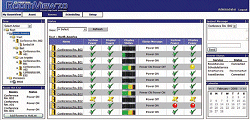
CRESTRON'S ROOMVIEW provides a 'big-picture view' of a campus' entire presentation setup.
Standardization is also critical to successful
use and management of AV controller
equipment, say campus technology
pros. UAMS has installed a dozen AMX
controllers and two Creston systems in all
of its large lecture halls that seat 100 or
more students. And from a user perspective,
Bailey says, the key to the success of
the university's AV control implementations
lies in the consistency of the GUIs
of the various touchpanels. "Between the
two systems, we strive to make the GUI as
close to identical as possible, from room to room and from system to system," he
says. "The presenters know that the PowerPoint
button, the DVD controls, and the
volume controls all are in the same place.
We never want them to worry about the
technology. They shouldn't even have to
think about it. They know now that they
can walk in, push a button, and everything
works."
But Bailey isn't alone in his quest for
AV controller interface standards. Greg
Bronson, project leader in the Academic
Technology Services department of Cornell University (NY), has been evangelizing
the standards cause for years. In
fact, he's one of the prime movers behind
an InfoComm-sponsored initiative to
encourage system integrators to provide
AV controller interfaces with a consistent
look and feel. Bronson served as the first
chairperson of InfoComm's Dashboard
for Controls group, launched in 1999/
2000. (UAMS' Bailey was in the group,
as well.) Supporters of the initiative
believe that operation of a professionally
installed AV presentation system should
be as easy as driving a car. "Think about
it: If I need to rent a car, and I decide that
I'd like to get a convertible for a change, I
shouldn't have to pull out a manual
because I usually drive a hardtop," Bronson
explains. "And I don't: The gas pedal
isn't on the left and the steering wheel
isn't in the back seat, because there are
standards in place. The 'interfaces' in
both types of cars have the same look and
feel. Why should AV controller interfaces
be any different?"
The 'interfaces' in cars--gas pedals, steering wheels--have the same look and feel. Why should AV controller interfaces be different? -- Greg Bronson, Cornell
To manage a range of multimedia
resources, Cornell has deployed several
models of Crestron controllers in classrooms
and conference rooms throughout
the campus. The controllers are built
into lecterns and are flush-mounted on
hardware racks. For classrooms integrated
with dedicated resources, the
touchpanel has become the primary
instructor interface, Bronson says. In
fact, the InfoComm Dashboard project
was an outgrowth of Bronson's work to
standardize touchpanel design and function
campuswide in those deployments.
"This is primarily an issue of interoperability,"
Bronson explains. "If you look
at the basic premise of a control system
in an AV environment, it's really a protocol
converter; it has to be able to communicate
with all the other devices, so
that system has to be based on standards.
As more and more of this technology
moves toward an IT-based infrastructure,
it really has to embrace the standards of
the IT department, so it can conform to
IT's needs and expectations."
FOCUS ON REMOTE AV
'Remote access allows me to better manage the technology: I can check how many
hours [the control podium] has been turned on, which buttons are being pushed, and
which features are being used. I might notice, for instance, that none of the presenters
are using the VCRs, so when I design a new room, I might leave that piece of
equipment out of the mix.'-- Ernie Bailey, University of Arkansas for Medical Sciences
Even as far back as 2000, the school
had rolled out guidelines that Bronson
describes as a "manufacturer-agnostic"
document. Still, "We didn't want to
undercut programmer creativity," he
says. "We don't say that certain buttons
have to be a certain color, or that certain
graphic styles have to be used. We do
want to see the difference between that
convertible and that hardtop." But the
Cornell guidelines did serve as the basis
for InfoComm's Dashboard for Controls
Template, Dashboard for Controls
Design Reference, and Dashboard for
Controls Integrators Guide, available
for free download.
"This project has moved along, with
manufacturer and design-consultant support,"
says InfoComm's Lemke. "Now,
as schools start the process of figuring
out how they're going to do their control
programming, they can download a PDF
with examples, design principles, and
even a template that they can use to guide
them and their system integrators."
Though this initiative is not new, in the
end, it is the push for standards that may
prove to be the most significant innovation
in the AV controller space. The
question now is: As interactive whiteboard
competitors vie for installation
sites, and features and capabilities proliferate,
will standardization become essential
there, too? Only time will tell.
::WEBEXTRAS :: Tour tech-enabled classrooms at the
University of Maryland-College Park, at
Campus Technology 2007 in Washington,
DC, July 30-Aug. 2 :: Remote classroom support cuts costs
at the University of Richmond (VA) ::
Tips for demystifying input/output jacks and maintaining a flexible AV system.
About the Author
John K. Waters is a freelance journalist and author based in Mountain View, CA.